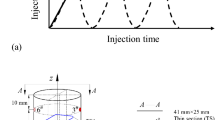Abstract
This study, which presents the results of numerous tests on the sensitivity of mortar permeability under conventional triaxial loading, represents tests carried out over more than a year at various confining pressures under monotonic loading or with loading-unloading cycles. Permeability is measured on a sample, dried prior to the test, by injecting argon—a neutral gas. A description of the experimental method based on applying a permanent flow is given as well as the technique of test study used. In this work, we chose to measure permeability under loading at different levels of deviatoric stress and strain since this corresponds more closely to the real conditions under which the works are used. Preliminary tests showed that the permeability under load was susceptible to early appearance of microcracks and began to increase noticeably towards 75/80% of the stress peak. Further tests were then carried out with loading-unloading cycles for stress levels beyond the stress peak. The authors have shown that permeability inceases very rapidly, starting from this peak. This is irreversible as the measurements taken after unloading the sample prove. The different tests also prove that the damage level is insufficient to allow for a description of variation in permeability, as it clearly depends on the degree to which the microcracks have opened. Such a claim is supported by results where this variation is presented in relation to lateral strain.
Résumé
Ce travail présente le résultats de nombreux essais sur l'étude de la sensibilité de la perméabilité d'un mortier sous chargement triaxial conventionnel, il représente plus d'un an de tests effectués sous chargement monotone ou avec cycles de charge—décharge. La perméabilité est mesurée sur échantillon préalablement séché par injection d'un gaz neutre. La méthodologie expérimentale basée sur l'application d'un régime permanent d'écoulement est détaillée ainsi que la technique de dépouillement des essais. Dans ce travail nous avons fait le choix de mesurer la perméabilité sous chargement, à différents niveaux de déviateur et de déformation car cela correspond plus aux conditions réelles d'utilisation des ouvrages. Quelques tests préliminaires ont montré que la perméabilité sous charge était bien sensible à l'apparition précoce des microfissures et qu'elle commence à augmenter notablement vers 75 à 80% du pic de contrainte. Des tests complémentaires ont ensuite été menés avec des cycles de chargement déchargement pour des niveaux de sollicitation au delà du pic de contraintes. Nous avons montré que la perméabilité augmente très rapidement à partir de ce pic et ceci irréversiblement comme le prouvent les mesures après déchargement de l'échantillon. Ces différents tests prouvent aussi que le niveau d'endommagement est insuffisant pour décrire la variation de perméabilité car elle dépend manifestement du degré d'ouverture des microfissures. Les résultats où cette variation est présentée en fonction de la déformation latérale prouvent cette assertion.
Similar content being viewed by others
References
Bungey, J. H. and Millard, S. G., ‘Testing of Concrete in Structures’, Third Edition (Chapman and Hall, 1996), 286p.
Wägner, F., Schober, G. and Mörtel, H., ‘Measurement of the gas permeability of autoclaved aerated concrete in conjonction with its physical properties’,Cem. Concr. Res. 25 (8) (1995) 1621–1626.
Sanjuan, M. A. and Munoz-Martialy, R., ‘Influence of the age on air permeability of concrete’,Journal of Materials Science 30 (1995) 5657–5662.
Norton, P. T. and Pletta, D. H., ‘The permeability of gravel concrete’, Proceedings,Journal of the American Concrete Institute 27 (1931) 1093–1132.
Wiley, G. and Coulson, D. C., ‘A simple test for water permeability of concrete’, Proceedings,34 (1937) 65–75.
Levitt, M., ‘Non-destructive testing of concrete by the initial surface adsorption method’, Proceedings of the Symposium on NDT of Concrete and Timber, (ICE, London, 1969), 23–36.
Figg, J. W., ‘Determining the water content of concrete panels’,Magazine of Concrete Research 24 (79) (1972) 94–96.
Hansen, A. J., Ottosen, N. S. and Petersen, C. G., ‘Gas-permeability of concrete in situ: theory and pratice’, in: ‘In Situ/Nondestructive Testing of Concrete, ACI SP-82’, (American Concrete Institute, Detroit, 1984) 543–556.
Kasai, Y., Matsui, I. and Nagano, M.. ‘On site rapid air permeability test for concrete’, in ‘In Situ/Non-destructive Testing of Concrete, ACI SP-82’, (American Concrete Institute, Detroit, 1984) 525–541.
Skoczylas, F. and Henry, J. P., ‘A study of the intrinsic permeability of granite to gas’,Int. J. Rock Mech. Min. Sci & Geomech. Abstr. 32 (2) (1995), 171–179.
Abbas, A., Carcasses, M. and Ollivier, J. P., ‘Gas permeability of concrete in relation to its degree of saturation’,Mater. Struct. 32 (215) (1999) 3–8.
Ollivier, J. P. and Yssorche, M. P., ‘Microstructure et perméabilité aux gaz des bétons de hautes performances’ in ‘Les Bétons à Hautes Performances, Caractérisation, durabilité, applications’, (Presses de l'École Nationale des Ponts et Chaussées 1992), 271–287.
Saito, M. and Ishimori, H., ‘Chloride permeability of concrete under static and repeated loading’,Cem. Concr. Res. 25 (4) (1995) 803–808.
Samaha, H. R. and Hover, K. C., ‘Influence of microcracking on the mass transport properties of concrete’,ACI Materials J 89 (4) (1992) 416–424.
Tawfiq, K., Armaghani, J. and Vysyaraju, J. R., ‘Permeability of concrete subjected to cyclic loading’,Transp. Res. Rec. 1532 (1996), 51–59.
Stormont, J. C. and Daemen, J. J. K., ‘Laboratory study of gas permeability changes in rock salt during deformation’,Int. J. Rock Mech. Min. Sci & Geomech. Abstr. 29 (4) (1992) 325–342.
Hearn, N., Detwiler, R. J. and Sframeli, C., ‘Water permeability and microstructure of three old concretes’,Cem. Concr. Res. 24 (4) (1994) 663–640.
Iffly, R., ‘Étude de l'écoulement des gaz dans les milieux poreux’,Revue IFP XI (6) (1956) 757–1018.
Bruhat, G., ‘Thermodynamique-Cours de Physique Générale’, (Masson & Cie, 1963).
Coussy, O., ‘Mécanique des milieux poreux’, (Éditions Technip, Paris, 1990).
Liu, T. C. Y., Nilson, A. H. and Slate, F. O., ‘Stress-strain response and fracture of concrete in uniaxial and biaxial compression’, Proceedings,Journal of American Concrete Institute 69 (1972) 291–295.
Author information
Authors and Affiliations
Rights and permissions
About this article
Cite this article
Meziani, H., Skoczylas, F. An experimental study of the mechanical behaviour of a mortar and of its permeability under deviatoric loading. Mat. Struct. 32, 403–409 (1999). https://doi.org/10.1007/BF02482711
Received:
Accepted:
Issue Date:
DOI: https://doi.org/10.1007/BF02482711




